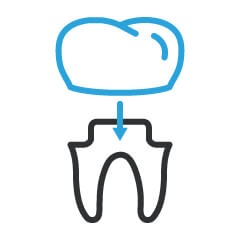Root Canal
Root Canal
Endodontics
Endodontics is the branch of dentistry that tends to the nerves of the teeth. Root canals are perhaps the most infamous procedures in dentistry and the most frequent when relating to endodontics. Should a tooth become infected, it is most likely linked to the root of the tooth. The affected nerves need to be removed. Should the infection not be taken care of, it can turn in to an abscess. This is much more severe and could result in bone loss in the jaw.
Root Canal
Procedure
During a root canal, the area surrounding the tooth is numbed at the beginning of the procedure. The dentist then uses a drill to make an opening through the tooth in to the canal. This opening will then allow the dentist to remove any infected tissue and clean the canal. Once the infected tissue is taken care of, the opening is filled with a sealant called gutta percha. It is strongly suggested that any tooth that has undergone a root canal also is fitted with a crown. This will enhance the appearance of the tooth, as well as improve the chances of the root canal being successful long term.
Root Canal
The Truth Behind Root Canals
“Root Canal” has become a bit of an alarming term for patients to think about. With advancements in dental technology and the benefits of the procedure itself, root canals are far less frightening than one would think. Pain medication and the use of local anesthetics make the procedure far less painful. In many cases, over the counter medication is sufficient for treating pain after a root canal. You doctor may however prescribe medication if necessary. The procedure will also relieve any discomfort you might have had prior to the root canal. This will allow you to go back to enjoying foods without any pain from cold, heat or biting too hard. If you are enduring any pain, contact your dentist today.
Root Canal
Apicoectomy (Endodontic Surgery)
Should a root canal be unsuccessful, an apicoectomy needs to be performed. In cases where an infection lingers or comes back after a root canal, an apicoectomy is usually necessary. It is sometimes difficult to ensure that a root canal takes care of all of the infected tissue, especially when the infection spreads to many nerves. In an apicoectomy the tip of the root of the tooth is removed and a filling is put in its place.
Most of the time, a second root canal will be considered before moving forward with an apicoectomy. Root canals are less complicated and less invasive. Prior to the apicoectomy beginning, a local anesthetic is used to numb the area. The dentist will create a small incision in your gum to reveal the root of the tooth. Inflamed tissue will be removed and the area will be cleaned. The surgery is contained to a small area and only a few millimeters are taken from the root. Dentists will use small precision instruments and magnification to perform the surgery. Because it is such a precise procedure, it has a high success rate. Once the root is removed and the filling is placed, the gums are then sutured. It is possible that you might have to return to remove the sutures. In some cases, dissolving sutures may be used that would not require you to come back. The bone will begin to heal around the root over the next several months.
Root Canal
Related Procedures
Crowns
The crown will be placed on your tooth with cement. Once you’re done, you will see that your old smile has returned. Crowns are strong and…
Retreatment
A new infection in the tooth can be caused by decay when the root canal filling material is exposed to bacteria. A broken, cracked or loose…



